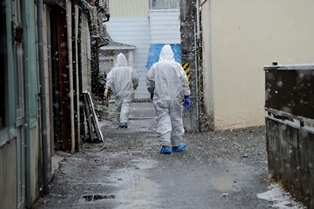Three years after the tsunami, the Red Cross is supporting long-term recovery
2014/03/11

By Francis Markus, IFRC
Three years on from the triple disaster which battered north-eastern Japan on March 11, 2011, there is clear progress towards recovery in many communities. However, hundreds of thousands remain in temporary housing and many Fukushima evacuees fear they may never return home.
“There is still a continuous need for us to stand by the affected populations and the problems that evacuees in Fukushima face are very particular,” said Tadateru Konoé, President of the Japanese Red Cross Society and of the International Federation of Red Cross and Red Crescent Societies (IFRC).
“It’s difficult to see any future in some of the areas which have had to be abandoned due to the radiation,” he said, speaking on a visit to Namie, in the restricted area close to the nuclear plant, which suffered a triple meltdown after the 9-magnitude earthquake and tsunami.
A key role for the Red Cross
Across the area worst affected by the earthquake and tsunami, the Red Cross has played a key role in rebuilding hospitals, clinics, kindergartens and other facilities, using 60 billlion yen in funds donated through National Societies worldwide. It has also supported livelihoods, infrastructure projects and small and medium business revival in the three worst-affected prefectures, using 40 billion yen donated by the Kuwaiti government.
On the whole, rebuilding damaged and destroyed infrastructure has been moving much faster than the building of new permanent homes.
In addition to the complicated process of land acquisition including negotiation with landowners, a rise in demand for construction throughout affected areas and the rises in material and labour costs have also meant that government plans for housing reconstruction have been delayed.
The long wait in cramped prefabricated homes – some of which are starting to deteriorate – or rented apartments is causing stress and some of those who have the means to do so are buying new homes instead of waiting to be resettled.
They are able to take with them many of the electrical appliances which Japanese Red Cross Society donated to more than 133,000 families when they moved into temporary accommodation – including fridge, microwave, washing machine, rice cooker, hot water dispenser and television.
Moving on to a new home
But the Red Cross Red Crescent has supported several housing projects which are now completed, and the mainly elderly residents like Satsuko Takezawa, 73, have moved in. “I would have had nowhere to go from temporary housing if I hadn’t got this place. It’s really wonderful, I have nothing to complain about,” Mrs Takezawa says in the kitchen of her new home at a public housing project in Shinchi, Fukushima.
For some of the residents of Fukushima, the displacement is throwing up new problems and stresses. Thousands of former residents of the town of Namie are currently living in the nearby city of Iwaki.
Japanese Red Cross nurses are proving health and psychosocial visits to this displaced community, but, says Red Cross nurse Naomi Watanabe, many of them are stressed. “They don’t want their neighbours to know that they are from Namie, because they are afraid of people thinking they are getting special treatment from the government,” she says.
As well as providing support to those displaced by the Fukushima meltdown, the society has focused on increasing preparedness for nuclear accidents. It established a nuclear disaster resource centre at its headquarters last October, which is collecting information and experiences in a digital archive system and creating an operational manual for use in the event of future disasters.
There’s always more to do
Most of the large-scale recovery projects are now finished or nearing completion. Yet there’s a clear need for the Japanese Red Cross Society support to continue in a number of areas, such as helping nuclear evacuees or supporting the vulnerable elderly who remain in temporary housing with activities to help them stay physically healthy and create a sense of community.
Red Cross chapters in the worst-affected prefectures will take the lead locally in providing continuing support to disaster survivors until at least 2017. Activities such as the summer camps for disaster area children, held in 2012 and 2013 in northern Japan’s Hokkaido island are expected to be organised locally in the three worst-hit prefectures.
“We need to do everything we can to ensure that the public at large in Japan also does not forget about the affected communities, and will continue to think of the survivors and support them on their road to recovery in a variety of ways,” says Kenji Takeuchi, Director General the recovery task force for the Great East Japan Earthquake and Tsunami.















